
Jean Balue was a French cardinal and minister of Louis XI. Born without resources, he managed to climb the political ladder by exploiting connections, to whom he often did not remain loyal, and by making himself an indispensable agent of the king's purposes in a time of political disorder in France. His services were as much military as ecclesiastical, bringing him the critical task of defending the city of Paris against the King's enemies. His work as a diplomat in dealing with Duke Francis of Brittany and with Charles de France brought him the office of first minister to the King. Balue overreached himself in negotiating a treaty between the King and Charles the Bold, who had become Duke of Burgundy and was trying to recover all his family inheritance. Secret correspondence revealed that he might have been playing both sides in the negotiation, and he was arrested, and held on charges of treason from 1469 to 1481, while King and Pope argued over jurisdiction. After the death of King Louis and Pope Sixtus, the new French king, Charles VIII, appointed Balue his ambassador in Rome.
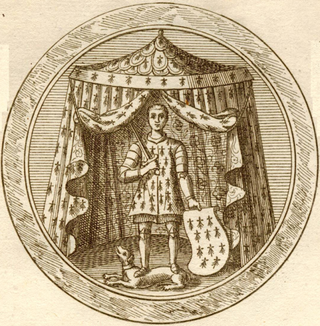
John V, sometimes numbered as VI, bynamed John the Wise, was Duke of Brittany and Count of Montfort from 1399 to his death. His rule coincided with the height of the Hundred Years' War between England and France. John's reversals in that conflict, as well as in other internal struggles in France, served to strengthen his duchy and to maintain its independence.

The House of Rohan is a Breton family of viscounts, later dukes and princes in the French nobility, coming from the locality of Rohan in Brittany. Their line descends from the viscounts of Porhoët and is said to trace back to the legendary Conan Meriadoc. Through the Porhoët family, the Rohans are related to the Dukes of Brittany, with whom the family intermingled again after its inception. During the Middle Ages, it was one of the most powerful families in the Duchy of Brittany. The Rohans developed ties with the French and English royal houses as well, and they played an important role in French and European history.

Thomas Basin (1412–1491) was a French bishop of Lisieux and historian.
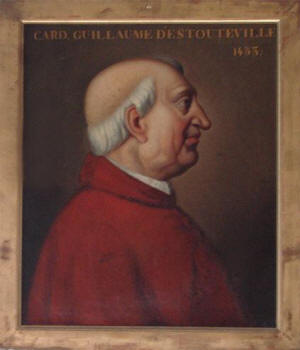
Guillaume d'Estouteville was a French aristocrat of royal blood who became a leading bishop and cardinal. He held a number of Church offices simultaneously. He conducted the reexamination of the case of Jeanne d'Arc and exonerated her of the charges against her. He reformed the Statutes of the University of Paris. In Rome he became one of the most influential members of the Curia, as the official Protector of France in church business. Pope Sixtus IV appointed him Chamberlain of the Holy Roman Church (Camerlengo). His great wealth allowed him to be a generous patron of the arts, especially in the building and adornment of churches.

Jargeau is a commune in the Loiret department in north-central France.
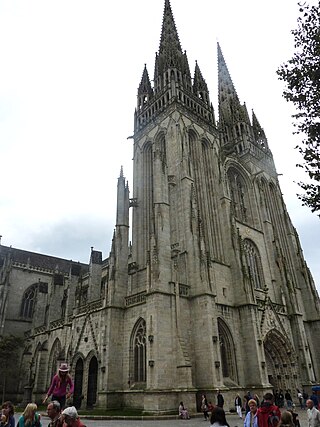
The Diocese of Quimper (–Cornouaille) and Léon is a Latin Church ecclesiastical territory or diocese of the Catholic Church in France. In 1853, the name was changed from the Diocese of Quimper (–Cornouaille) to the Diocese of Quimper (–Cornouaille) and Léon.

Seigneurs and Dukes of Retz owned the district of Retz or Rais, is in South Brittany.

Gilles de Rais, Baron de Rais, was a knight and lord from Brittany, Anjou and Poitou, a leader in the French army, and a companion-in-arms of Joan of Arc. He is best known for his reputation and later conviction as a confessed serial killer of children.

Nantes Cathedral, or the Cathedral of St. Peter and St. Paul of Nantes, is a Roman Catholic Gothic cathedral located in Nantes, Pays de la Loire, France. Construction began in 1434, on the site of a Romanesque cathedral, and took 457 years to finish in 1891. It has been listed since 1862 as a monument historique by the French Ministry of Culture.
The Archdeacon of Lothian was the head of the Archdeaconry of Lothian, a sub-division of the Diocese of St Andrews. The position was one of the most important positions within the medieval Scottish church; because of his area's large population and high number of parish churches, the Archdeacon of Lothian may have exercised more power than many Scottish bishops before the decline in archdiaconal powers after the 13th century.

The Diocese of Luçon is a Latin Church diocese of the Catholic Church in France. Its see is Luçon Cathedral in the commune of Luçon. The diocese comprises the department of Vendée. Created in 1317 out of the diocese of Poitiers, its existence was interrupted during the French Revolution, but it was restored in 1821, along with the Bourbon restoration.
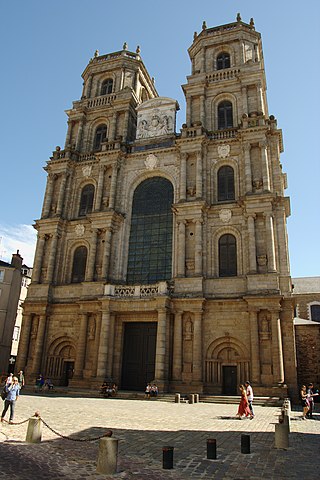
The Archdiocese of Rennes, Dol, and Saint-Malo is a Latin Church diocese of the Catholic Church in France. The diocese is coextensive with the department of Ille et Vilaine. The Archdiocese has 8 suffragans: the Diocese of Angers, the Diocese of Laval, the Diocese of Le Mans, the Diocese of Luçon, the Diocese of Nantes, the Diocese of Quimper and Léon, the Diocese of Saint-Brieuc and Tréguier, and the Diocese of Vannes.

The Diocese of Nantes is a Latin Church diocese of the Catholic Church in Nantes, France. The diocese consists of the department of Loire-Atlantique. It has existed since the 4th century. It is now suffragan of the Archdiocese of Rennes, Dol, and Saint-Malo, having previously been suffragan to the Archdiocese of Tours. Its see is Nantes Cathedral in the city of Nantes.

Amadeus VIII, nicknamed the Peaceful, was Count of Savoy from 1391 to 1416 and Duke of Savoy from 1416 to 1440. He was the son of Amadeus VII, Count of Savoy and Bonne of Berry. He was a claimant to the papacy from 1439 to 1449 as Felix V in opposition to Popes Eugene IV and Nicholas V.

The sieges of Vannes of 1342 were a series of four sieges of the town of Vannes that occurred throughout 1342. Two rival claimants to the Duchy of Brittany, John of Montfort and Charles of Blois, competed for Vannes throughout this civil war from 1341 to 1365. The successive sieges ruined Vannes and its surrounding countryside. Vannes was eventually sold off in a truce between England and France, signed in January 1343 in Malestroit. Saved by an appeal of Pope Clement VI, Vannes remained in the hands of its own rulers, but ultimately resided under English control from September 1343 till the end of the war in 1365.
François Prelati was an Italian cleric and alchemist who took part in the murders committed by Gilles de Rais in the 15th century. He claimed he could summon demons and involved Gilles in this practice.

The Lordship of Combourg, after 1575 the County of Combourg, was a barony centred on Combourg in the east of the Duchy of Brittany in France during the Middle Ages and the early modern period.
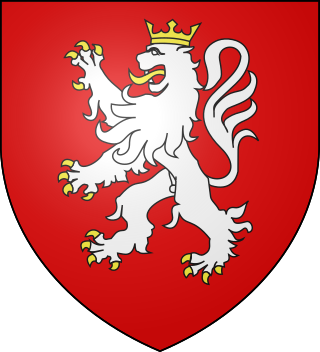
Olivier IV de Clisson (1300–1343), was a Breton Marche Lord and knight who became embroiled in the intrigue of Vannes and was subsequently executed by the King of France for perceived treason. He was the husband of Jeanne de Clisson who eventually became known as the Lioness of Brittany.





















